
Chaparral is a shrubland plant community found primarily in California, in southern Oregon and in the northern portion of the Baja California Peninsula in Mexico. It is shaped by a Mediterranean climate and infrequent, high-intensity crown fires.

Senegalia greggii, formerly known as Acacia greggii, is a species of tree in the genus Senegalia native to the southwestern United States and northern Mexico, from the extreme south of Utah south through southern Nevada, southeast California, Arizona, New Mexico and western Texas to Baja California, Sinaloa and Nuevo León in Mexico. The population in Utah at 37°10' N is the northernmost naturally occurring Senegalia species anywhere in the world.

Robinia neomexicana, the New Mexican, New Mexico, Southwest, desert, pink, or rose locust, is a shrub or small tree in the subfamily Faboideae of the family Fabaceae.

Juniperus californica, the California juniper, is a species of juniper native to southwestern North America.

The scaled quail, also commonly called blue quail or cottontop, is a species of the New World quail family. It is a bluish gray bird found in the arid regions of the Southwestern United States to Central Mexico. This species is an early offshoot of the genus Callipepla, diverging in the Pliocene.

Prosopis glandulosa, commonly known as honey mesquite, is a species of small to medium-sized, thorny shrub or tree in the legume family (Fabaceae).
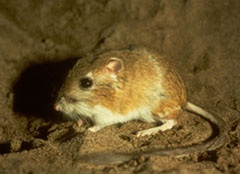
Ord's kangaroo rat is a kangaroo rat native to western North America, specifically the Great Plains and the Great Basin, with its range extending from extreme southern Canada to central Mexico.

Calliandra eriophylla, commonly known as fairy duster, is a low spreading shrub which is native to deserts and arid grasslands in California, Arizona, New Mexico, Texas, and Mexico.

The white-throated woodrat is a species of rodent in the family Cricetidae. It is found from central Mexico north to Utah and Colorado in the United States. It is primarily a western species in the United States, extending from central Texas west to southeastern California. Populations east of the Rio Grande in New Mexico and Trans-Pecos Texas, previously considered to be variants of the white-throated woodrat, have since 1988 been assigned to the white-toothed woodrat.
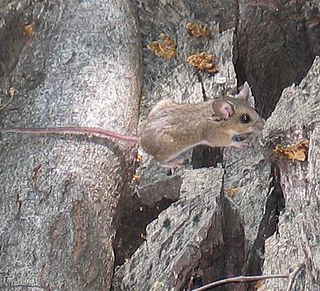
The brush mouse is a species of rodent in the family Cricetidae. It is found in mountainous areas of Mexico and the western United States at altitudes over 2,000 m (6,600 ft).

The yellow-nosed cotton rat is a species of rodent in the family Cricetidae. It is native to Mexico and to the states of Arizona, New Mexico, and Texas in the United States, where it inhabits mountain grassland, scrub, and pinyon-juniper woodland. It is common over much of its wide range and the IUCN considers it to be of "least concern".

An oak forest is a plant community with a tree canopy dominated by oaks. In terms of canopy closure, oak forests contain the most closed canopy, compared to oak savannas and oak woodlands.
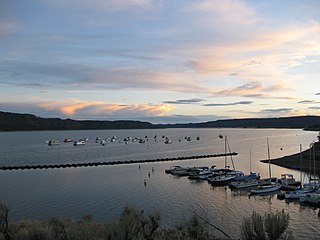
Navajo State Park is a state park of Colorado, USA, on the north shore of Navajo Lake. Touted as Colorado's answer to Lake Powell, this reservoir on the San Juan River begins in Colorado's San Juan Mountains and extends 20 miles (32 km) into New Mexico. Its area is 15,000 acres (6,100 ha), and it has 150 miles (240 km) of shoreline in two states. Park activities include boating, houseboating, fishing, camping, and wildlife viewing. There is a New Mexico state park at the southern end of the lake.
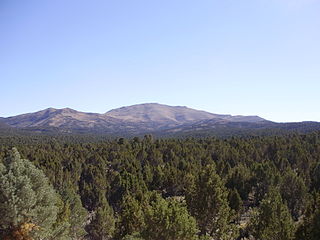
Pinyon–juniper woodland, also spelled piñon–juniper woodland, is a biome found mid-elevations in arid regions of the Western United States, characterized by being an open forest dominated by low, bushy, evergreen junipers, pinyon pines, and their associates. At lower elevations, junipers often predominate and trees are spaced widely, bordering on and mingling with grassland or shrubland, but as elevation increases, pinyon pines become common and trees grow closer, forming denser canopies. Historically, pinyon-juniper woodland has provided a vital source of fuel and food for peoples of the American Southwest.
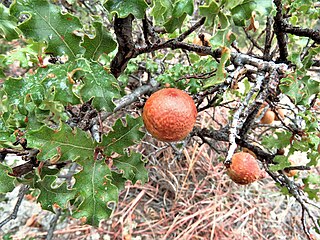
Quercus pungens, commonly known as the sandpaper oak or scrub oak, is a North American species evergreen or sub-evergreen shrub or small tree in the white oak group. There is one recognised variety, Quercus pungens var. vaseyana, the Vasey shin oak. Sandpaper oak hybridizes with gray oak in the Guadalupe Mountains of New Mexico and Texas.

Quercus oblongifolia, commonly known as the Mexican blue oak, Arizona blue oak, Blue live oak or Sonoran blue oak, is an evergreen small tree or large shrub in the white oak group.
Mimosa texana is a shrub in the family Fabaceae. It is commonly known as the Texas mimosa, the Texas catclaw or the Wherry mimosa and is endemic to upland regions of Mexico and Texas. This species used to be classified as Mimosa biuncifera but it was found that phenotypic variations occurred across its range and a new taxonomy was proposed by Rupert C. Barneby in 1986, splitting the species into Mimosa aculeaticarpa var. biuncifera and Mimosa texana.
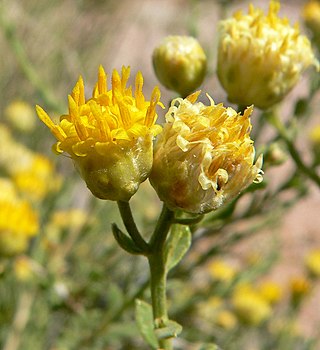
Acamptopappus sphaerocephalus is a species of flowering plant in the family Asteraceae known by the common name rayless goldenhead. It is native to the southwestern United States, where it occurs in southern California, southern Nevada, southern Utah, and Arizona.

Garrya wrightii is a species of flowering plant in the family Garryaceae known by the common names Wright's silktassel, quinine-bush, coffee berry, bearberry, feverbush, and grayleaf dogwood.

Purshia glandulosa is a species of flowering plant in the rose family known by the common names antelope bitterbrush, desert bitterbrush, Mojave antelope brush, and cliff-rose.




















